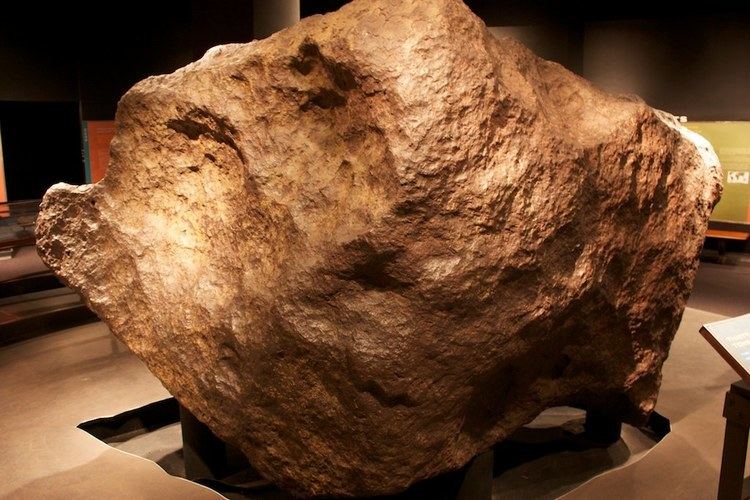Type Iron Group IIIAB Region Nordgronland | Structural classification Octahedrite, medium Country Greenland | |
 | ||
Composition 7.58% Ni, 19.2 ppm Ga, 36.0 ppm Ge, 5.0 ppm Ir | ||
The Cape York meteorite is named for Cape York, near the location of its discovery in Savissivik, Meteorite Island, Greenland, and is one of the largest iron meteorites in the world.
Contents
History
The meteorite collided with Earth nearly 10,000 years ago. The iron masses were known to Inuit as Ahnighito (the Tent), weighing 31 metric tons (31 long tons; 34 short tons); the Woman, weighing 3 metric tons (3.0 long tons; 3.3 short tons); and the Dog, weighing 400 kilograms (880 lb). For centuries, Inuit living near the meteorites used them as a source of metal for tools and harpoons. The Inuit would work the metal using cold forging—that is, by stamping and hammering it.
The first stories of its existence reached scientific circles in 1818. Five expeditions between 1818 and 1883 failed to find the source of the iron. It was located in 1894 by Robert E. Peary, the famous American Navy Arctic explorer. Peary enlisted the help of a local Inuit guide, who brought him to Saviksoah Island, just off northern Greenland's Cape York in 1894. It took Peary three years to arrange and carry out the loading of the heavy iron meteorites onto ships. It required the building of Greenland's only (small and short) railroad. Peary sold the pieces for $40,000 to the American Museum of Natural History in New York City where they are still on display.
Today the 3.4 m x 2.1 m x 1.7 m piece named Ahnighito (The Tent) is open for viewing at the American Museum of Natural History in the Arthur Ross Hall. It is the heaviest meteorite that has ever been relocated. It is so heavy that it was necessary to build its display stand so that the supports reached directly to the bedrock below the museum.
In 1963, a fourth major piece of the Cape York meteorite was discovered by Vagn F. Buchwald on Agpalilik peninsula. The Agpalilik meteorite, also known as the Man, weighs about 20 metric tons (20 long tons; 22 short tons), and it is currently on display in the Geological Museum of the University of Copenhagen, Denmark. Other smaller pieces have also been found, such as the 3 metric tons (3.0 long tons; 3.3 short tons) Savik I meteorite found in 1911 and the 250 kilograms (550 lb) Tunorput fragment found in 1984.
Specimens
Each of the most important fragments of Cape York has its own name (listed in order of discovery date):
- Ahnighito (the Tent), 30,900 kilograms (68,100 lb), 1884-1897, Meteorite Island, 76°04'N - 64°58'W
- Woman, 3,000 kilograms (6,600 lb), 1897, Saveruluk, 76°09'N - 64°56'W
- Dog, 400 kilograms (880 lb), 1897, Saveruluk, 76°09'N - 64°56'W
- Savik I, 3,400 kilograms (7,500 lb), 1913, Savequarfik, 76°08'N - 64°36'W
- Thule, 48.6 kilograms (107 lb), summer 1955, Thule, 76°32'N - 67°33'W
- Savik II, 7.8 kilograms (17 lb), 1961, Savequarfik, 76°08'N - 64°36'W
- Agpalilik (the Man), 20,000 kilograms (44,000 lb), 1963, Agpalilik, 76°09'N - 65°10'W
- Tunorput, 250 kilograms (550 lb), 1984
Composition and classification
It is an iron meteorite (medium octahedrite) and belongs to the chemical group IIIAB. There are abundant elongated troilite nodules. The troilite nodules contain inclusions of chromite, sulfides, phosphates, silica and copper. The rare nitride mineral carlsbergite (CrN) occurs within the matrix of the metal phase. Graphite was not observed and the nitrogen isotopes are in disequilibrium.
